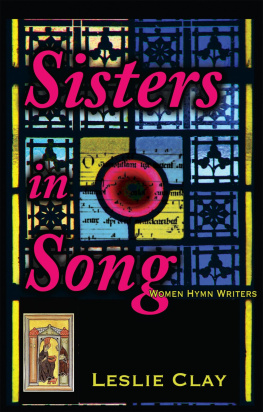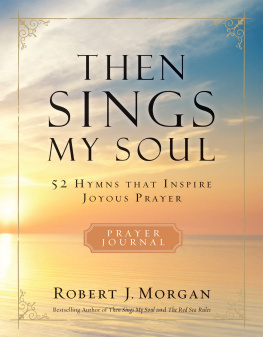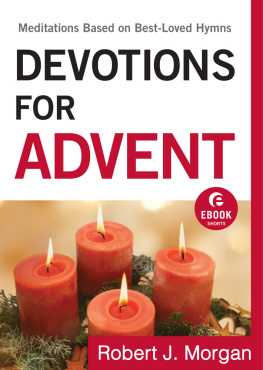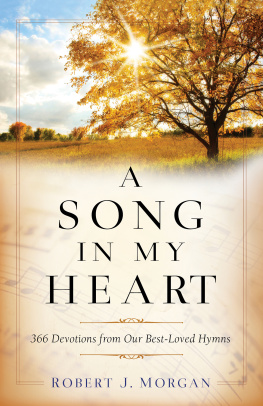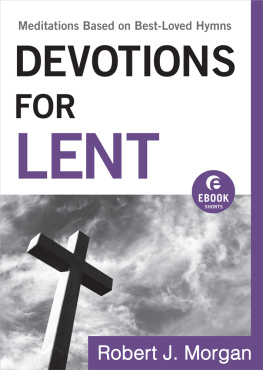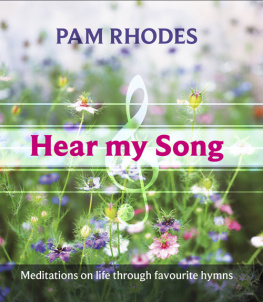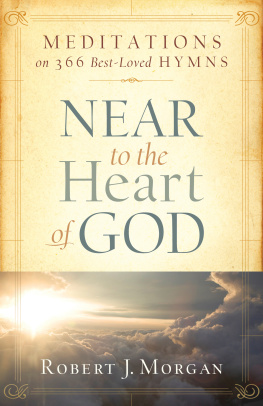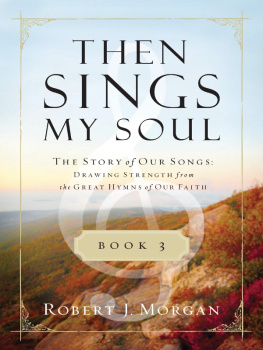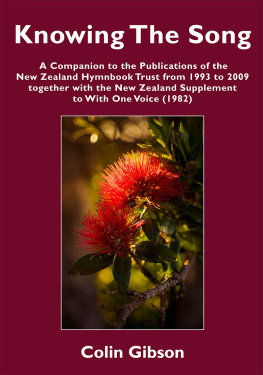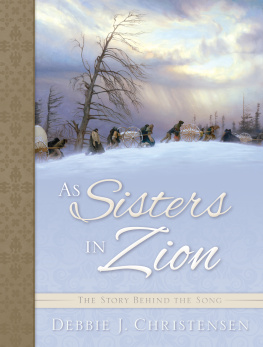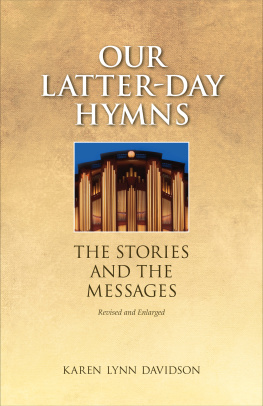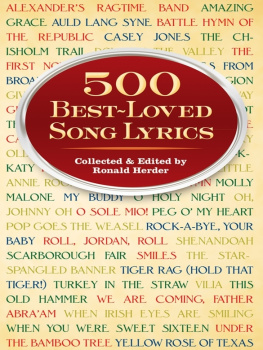Leslie Clay - Sisters in Song: Women Hymn Writers
Here you can read online Leslie Clay - Sisters in Song: Women Hymn Writers full text of the book (entire story) in english for free. Download pdf and epub, get meaning, cover and reviews about this ebook. year: 2013, publisher: eBookIt.com, genre: Non-fiction. Description of the work, (preface) as well as reviews are available. Best literature library LitArk.com created for fans of good reading and offers a wide selection of genres:
Romance novel
Science fiction
Adventure
Detective
Science
History
Home and family
Prose
Art
Politics
Computer
Non-fiction
Religion
Business
Children
Humor
Choose a favorite category and find really read worthwhile books. Enjoy immersion in the world of imagination, feel the emotions of the characters or learn something new for yourself, make an fascinating discovery.
- Book:Sisters in Song: Women Hymn Writers
- Author:
- Publisher:eBookIt.com
- Genre:
- Year:2013
- Rating:5 / 5
- Favourites:Add to favourites
- Your mark:
- 100
- 1
- 2
- 3
- 4
- 5
Sisters in Song: Women Hymn Writers: summary, description and annotation
We offer to read an annotation, description, summary or preface (depends on what the author of the book "Sisters in Song: Women Hymn Writers" wrote himself). If you haven't found the necessary information about the book — write in the comments, we will try to find it.
Sisters in Song: Women Hymn Writers — read online for free the complete book (whole text) full work
Below is the text of the book, divided by pages. System saving the place of the last page read, allows you to conveniently read the book "Sisters in Song: Women Hymn Writers" online for free, without having to search again every time where you left off. Put a bookmark, and you can go to the page where you finished reading at any time.
Font size:
Interval:
Bookmark:

This project began in 2008. The women of Broadway Christian Church held their annual womens retreat on a snowy February weekend. The theme was music. I offered to look up the familiar hymns written by women and play them on the old piano at the retreat site as the women filtered in on opening day. While researching the subject, the whole thing grew beyond expectation and I decided to write about what I found. Other members of the retreat committee took some of that research and incorporated it into other retreat activities. Afterwards, as time permitted, I delved deeper. Womens contributions to hymnody are vast and inspiring! Saints or sinners, their stories are humbling. So many women wrote when they were in poverty, isolation or pain. Their faith shone even in times of distress. But those who were blessed with good health and circumstance expressed their faith beautifully as well.
At the onset of my research, I came upon a book published in 1903, Songs from the Hearts of Women , that recited the stories of women-written hymns. It is impressive to learn how many long forgotten hymns inspired people over a century earlier. Many are still well known, from the first hymn children learn, Jesus Loves Me, to the patriotic America the Beautiful, to the timeless hymns of Fanny Crosby. But there are many wonderful hymns written since 1903. Though I found other books dealing with women hymn writing, they were either from an academic/feminist perspective with lengthy articles on a limited number of writers, or they didnt deal with hymnists in the past century, or they concentrated on theological instruction. One recent book was mainly a study book with questions for group discussion, and the biographies took a secondary role. My book isnt written for academia, deals with many women both long gone and current in a more abbreviated way, and expects the reader to form her own opinions, if any, on the theology. I dont write so much from a feminist perspective as I do from a fondness for my personal favorite hymns.
I restricted myself to hymns found in current American hymn books or inspirational collections that appealed to me, and to those songs familiar to me. Many women in those books were noted translators, such as Catherine Winkworth and the Borthwick sisters, but they didnt compose the original words, and so were omitted with the exception of Jean Janzen, who translated or adapted the writings of medieval women, such as Hildegard Von Bingen, Mechthild von Magdeburg and Julian of Norwich. Some women wrote both the words and music, more so today than in centuries past. Many hymns were co-written with a man. I include those hymns women co-wrote. Many fine current writers and composers have been omitted, some by time and space, some by my lack of acquaintance with their work. I am sorry. Maybe I can amend this at a later time. I welcome any suggestions.
For each woman featured, I cite at least one hymn, especially those with an interesting background story. For women who were unusuallyamazo prolific, I may cite more than one. Yes, many women wrote more than one hymn of note, but unless the hymn was particularly meaningful to me, they werent featured. If you want more information on any particular person or hymn, the internet is a great resource. There are several sites that have good information, and often, current hymnists have their own websites. Some who have long since joined the church eternal have managed to establish a Facebook page. My sources were those found on the internet, the books I could get from our local public library, and my own hymnbooks. I have a brief bibliography at the end. A more scholarly approach would go far beyond this, but Im not aiming at a Ph.D. dissertation. I just want you to enjoy the contributions made by our sisters in song.
Thank you, women of Broadway Christian Church, for inspiring me. And thank you, my sister in life, Debra Sapp-Yarwood, for making this so much better than it would be otherwise.
Leslie Clay
Columbia, Missouri
2013
The history of women hymnists is more ex-tensive than you might expect. The scriptures identify Miriam and her song after escaping from bondage in Egypt (Exodus 15:20-21). Deborah sings (Judges 5:1-31). Hannah sings (1 Samuel 2:1-10). So does Mary (Luke 14:46-55). But the earliest known hymns for which we have both words and music come from plainchant. Most hymnists were anonymous. Women had little say in the music of the early church. In fact, from A.D. 574 until Martin Luther opened music to the laity, women couldnt sing in the church, because singing was restricted to the all-male clergy and choir. Women sang in their own monasteries and cloisters, however. Remarkably, the first chant for which authorship of both words and tune are known is from a woman, Hildegard von Bingen. You can hear recordings of her monophonic chants today, and they are sung by women. In her era and all eras past, women were restricted in their role, particularly in matters religious. But if a woman could say the hymns were inspired directly from God, usually in a vision, it might be accepted, albeit begrudgingly. No doubt there have been many hymns written by women through the centuries up to today who never got the credit. Many of the oldest hymns have no attribution.
Martin Luther, among other accomplishments, conceived and established congregational singing. Improved literacy and the invention of the moveable type printing press made it possible for everyone, not just the clergy, to sing in church. Luther wanted hymns to mean something to lay people, so hymns in the local vernacular were written. Hymnbooks were born, and with them, hymn writers.
Women-written hymns started to flourish in the nineteenth century with successive waves of spiritual revival sweeping through Europe and America. Though their roles were still restricted, women had more freedom to pursue activities beyond the home. I say this with the caveat that many hymns were written with a male pseudonym, as with Fanny Crosby or, as in the case of Lizzie Tourjee or May Moody, were written at the request or encouragement of a male relative. In the Victorian era, women rarely wrote the music, but wrote lyrics, though there were some notable exceptions as you will read in this book. Many Victorian era women wrote hymns for children, but a good number of those hymns have lived on as classics for all age groups. Victorian women hymnists also, overall, were a sickly lot. Perhaps their ailments kept them from going out to pursue other interests, thus providing time for meditation and creation of beautiful hymns.
Much of the hymnody in the second half of the 19th century now comes under the label of Gospel hymns. They were plain and readily understandable with many metaphors from daily life. They emphasized a personal relationship with and salvation through Jesus, heaven for the believer, and demand for action. The Gospel hymns were an important part of the evangelistic programs of such men as Dwight Moody and Billy Sunday.
Most of the writers of Gospel hymns were women or clergymen. Though women generally couldnt preach or speak in mixed meetings in those days, they could certainly write the hymns. And they provided them in quantity. I went to an auction and happened upon a hymnbook for general use published in 1905. Of the 245 hymns, 127 had lyrics by women, 93 by men, and 25 were by persons with initials or were otherwise anonymous. I couldnt help but note that none of the copyrights were held by women. The Gospel hymns have become less important in modern churches, and this may have been in part because they gave women more power to speak than some evangelical men wanted. In contrast to the 1905 book, a hymnbook at that same auction was published in 1935 and only 10% of its hymns were written by women. A general hymnbook in my personal library published in 1866 contains 466 hymns from the earlier part of the 19th century and before, and only 29, or 6%, were by women. If you attend a church, you may want to check out the hymnbook it uses. I hope the percentage has increased from both the 1866 and 1935 hymnbooks.
Font size:
Interval:
Bookmark:
Similar books «Sisters in Song: Women Hymn Writers»
Look at similar books to Sisters in Song: Women Hymn Writers. We have selected literature similar in name and meaning in the hope of providing readers with more options to find new, interesting, not yet read works.
Discussion, reviews of the book Sisters in Song: Women Hymn Writers and just readers' own opinions. Leave your comments, write what you think about the work, its meaning or the main characters. Specify what exactly you liked and what you didn't like, and why you think so.

